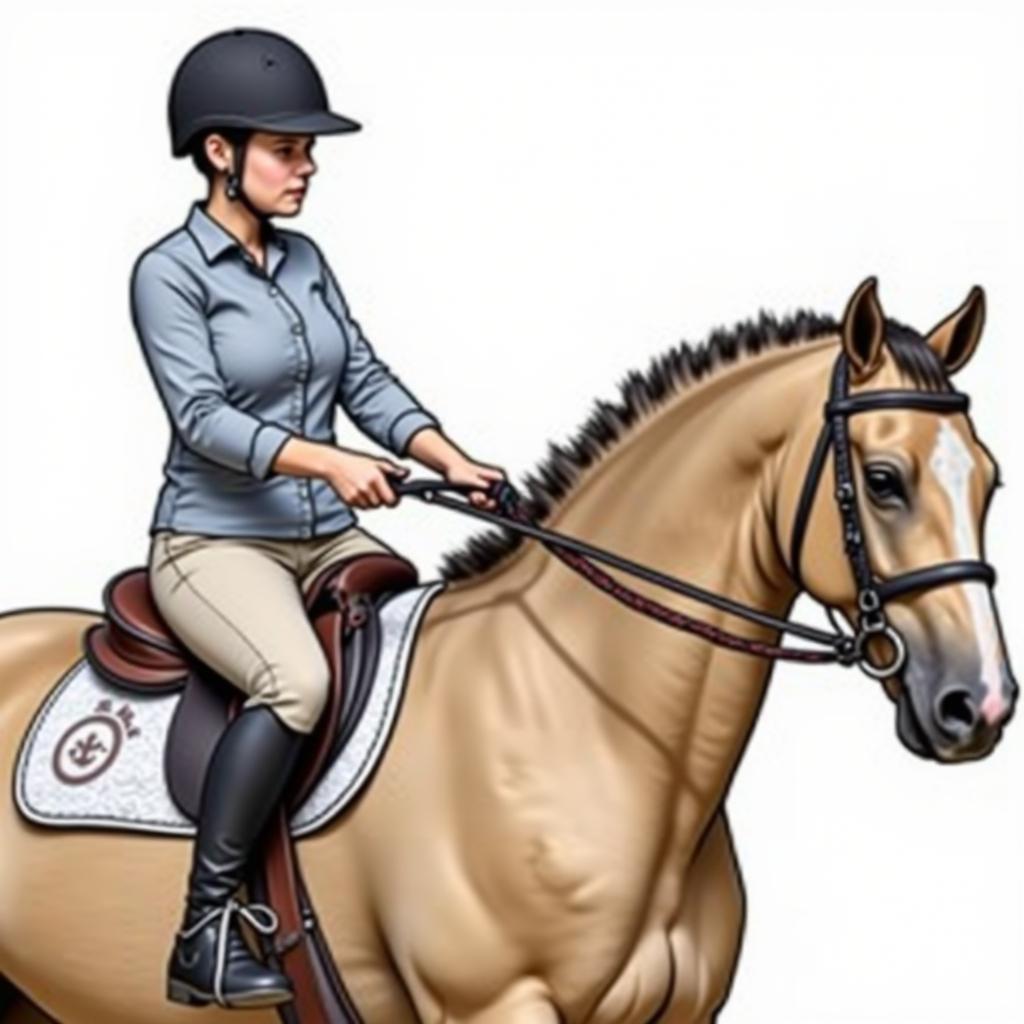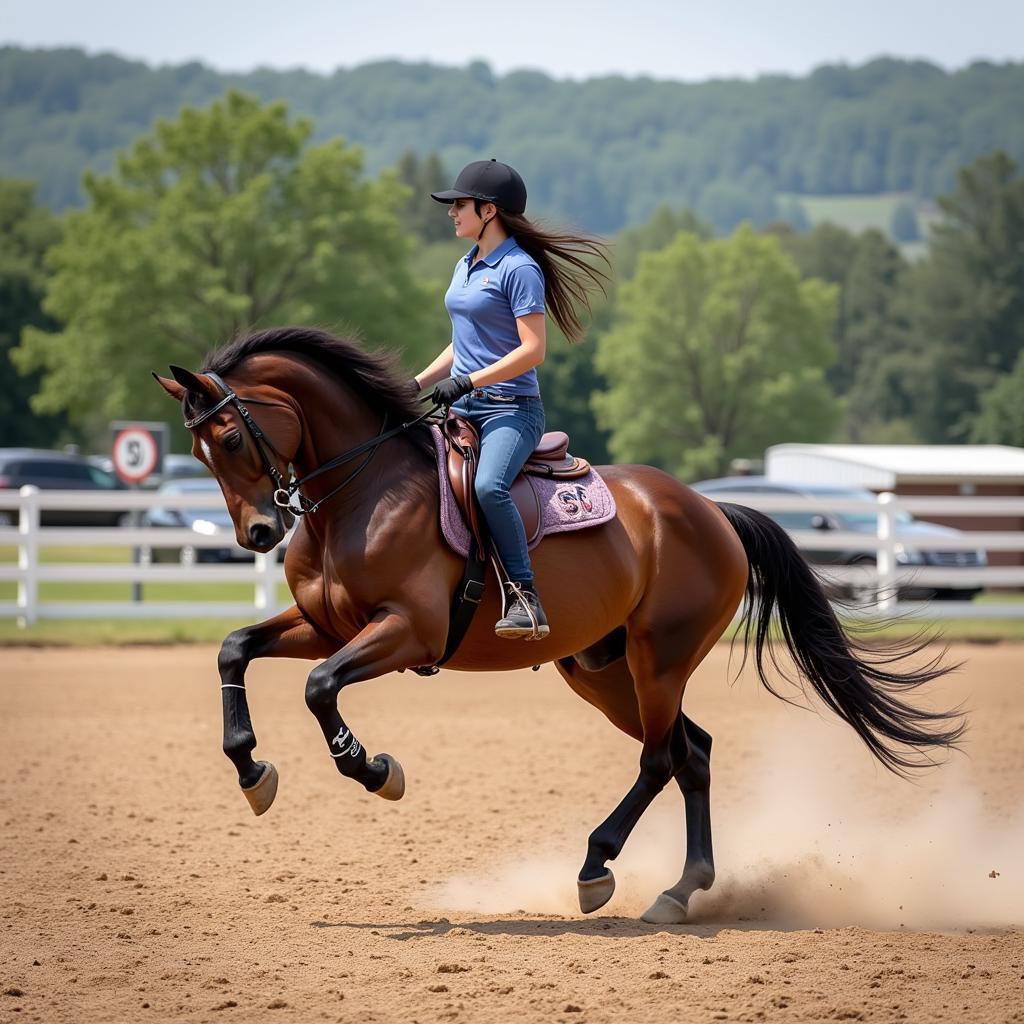Understanding how to stop a horse is fundamental for any rider, ensuring both safety and control. Whether you’re a beginner or an experienced equestrian, mastering the art of stopping effectively is crucial for a harmonious partnership with your horse. This guide delves into various techniques, addressing common challenges and offering expert advice to help you confidently bring your horse to a halt.
Mastering the Basics of Stopping a Horse
Stopping a horse isn’t simply pulling on the reins; it’s a coordinated effort involving your seat, legs, and reins. The first step involves preparing your horse by transitioning to a slower gait, like a trot or walk. As you approach the desired stopping point, sit deep in the saddle, engage your core, and gently close your fingers around the reins. Avoid sudden jerks, as this can startle the horse and create resistance. Instead, apply steady, even pressure, gradually increasing it until the horse responds.
 Horse Stopping Basics
Horse Stopping Basics
Maintaining a balanced posture is essential. Imagine a straight line running from your ear to your shoulder, hip, and heel. This alignment helps you maintain control and effectively communicate your intentions to the horse. Remember, clear communication is key to a successful stop.
Addressing Common Stopping Challenges
Horses, like humans, have individual personalities and quirks. Some might be naturally more responsive to cues, while others require more patience and training. A common issue is the horse resisting the stop, either by leaning on the bit, tossing their head, or simply ignoring the rider’s signals. In these situations, it’s crucial to remain calm and persistent.
Check your horse accessories shop for appropriate bits and tack. Sometimes, the equipment itself can contribute to resistance. If you suspect this is the case, consult with a qualified trainer or equine professional. They can assess your horse’s needs and recommend suitable alternatives. Also, make sure your horse doesn’t have any underlying health issues that could be contributing to the resistance. Regular vet check-ups are vital for maintaining your horse’s well-being.
Using Voice Commands to Enhance Stopping
Incorporating voice commands can further refine your horse’s response to stopping cues. Words like “whoa” or “halt” can become associated with the action of stopping, providing an additional layer of communication. Consistency is key when using voice commands. Always pair the verbal cue with the corresponding physical aids, ensuring a clear and consistent message.
Advanced Stopping Techniques for Experienced Riders
For experienced riders, advanced stopping techniques, such as the sliding stop or the one-rein stop, can add finesse and control to their riding. These techniques require precise timing and coordination between the rider and the horse. However, mastering these advanced stops can significantly enhance communication and responsiveness. Remember, practice makes perfect, and it’s best to learn these techniques under the guidance of a skilled instructor.
The Importance of Patience and Consistency
Regardless of the technique used, patience and consistency are paramount. Horses learn through repetition and positive reinforcement. Celebrate even the smallest successes with praise and encouragement. Building a trusting relationship with your horse is essential for effective communication and a safe, enjoyable riding experience. Don’t get discouraged if you encounter setbacks. Every horse is different, and what works for one may not work for another.
 Advanced Horse Stopping Techniques
Advanced Horse Stopping Techniques
“Patience is key when training a horse,” says renowned equestrian trainer, Sarah Miller. “Building a strong foundation of trust and understanding will pave the way for successful communication and effective stopping.”
Conclusion
Stopping a horse effectively is a fundamental skill that requires a combination of technique, patience, and clear communication. By understanding the basics, addressing common challenges, and practicing consistently, you can build a strong partnership with your horse and ensure a safe and enjoyable riding experience. Remember, mastering the art of stopping is an ongoing journey that requires dedication and a willingness to learn and adapt. Don’t hesitate to check out our homemade chew stop for horses article for further tips on horse care. And speaking of horse health, did you know about the connection between goldfish and worms? Read more in our article do goldfish stop horses from getting worms. Now that you are focused on caring for your horse, consider adding some shine with our horse polish.
FAQ
- Why won’t my horse stop? Possible reasons include inconsistent cues, improper equipment, or underlying health issues.
- What is the most common stopping cue? The most common cue is a combination of seat, leg, and rein aids.
- How can I improve my horse’s responsiveness to stopping cues? Consistent training, positive reinforcement, and clear communication are key.
- What are some advanced stopping techniques? Advanced techniques include the sliding stop and the one-rein stop.
- How do I prevent my horse from resisting the stop? Maintain a calm and assertive demeanor, use consistent cues, and address any underlying training or equipment issues.
- What is the role of voice commands in stopping a horse? Voice commands can reinforce other cues and provide an additional layer of communication.
- What should I do if my horse continues to have trouble stopping? Consult with a qualified riding instructor or equine professional for personalized guidance.
Do you have any other questions about how to stop a horse, or perhaps you’re curious about what happens when a professional rider takes a tumble? Check out our article about Christoph Wahler falls off horse.
For further assistance, please contact us at Phone: 0772127271, Email: [email protected] or visit our address: QGM2+WX2, Vị Trung, Vị Thuỷ, Hậu Giang, Việt Nam. We have a 24/7 customer support team ready to help.